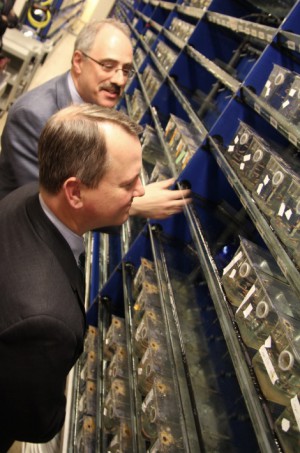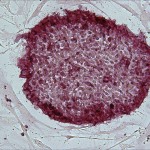
Leonard Zon (top) and Massachusetts Lt. Governor Timothy Murray in the Stem Cell Program's zebrafish facility. (Courtesy MLSC)
As a hematologist, I see all too many children battling blood disorders that are essentially untreatable. Babies with immune deficiencies living life in a virtual bubble, hospitalized again and again for infections their bodies can’t fight. Children disabled by strokes caused by sickle cell disease, or suffering through sickle cell crises that drug treatments can’t completely prevent. Children whose only recourse is to risk a bone marrow transplant—if a suitably matched donor can even be found.
Over the past 20 years, my lab and that of George Daley, MD, PhD, at Boston Children’s Hospital have worked hard to give these children a one-time, potentially curative option—a treatment that begins with patients’ own cells and doesn’t require finding a match.
We’re almost there—and may well get there with the support of the Commonwealth of Massachusetts.
Over the past year, the Stem Cell Program has figured out an optimal protocol for turning skin cells or blood cells from patients into induced pluripotent stem cells (iPS cells)—immature, unspecialized cells that can form any kind of tissue. We’ve created iPS cells from patients with more than 100 different diseases. We also know how to correct the genetic defects in the cells that are causing disease.That leaves just one step—using the corrected iPS cells to make the right kinds of healthy cells to treat the disease.
And that’s what’s been hardest for the stem cell field to tackle. While we can reprogram an iPS cell to make, say, a red blood cell, it turns out that making blood stem cells that are able to form all kinds of blood cells is difficult. With existing techniques, we end up producing cells that are in an embryonic stage or that don’t function the way a mature cell should.
While the specialized cells we create may look good in a dish, they may not have all the properties they need to make it in the “real world”—like being able to home to the right place in the body (in the case of blood disorders, the bone marrow).
It’s this kind of problem that the Massachusetts Life Sciences Center is helping us tackle systematically. Through their far-sighted investment, we are putting equipment and facility upgrades in place to take our work to the next level.

The prostaglandin-related drug FT1050, which improves blood stem cell engraftment, was identified with the help of zebrafish.(Soulkeeper/Wikimedia Commons)
Through these and other planned upgrades, we can get answers pretty quickly as to which cell therapy approaches are most promising.
Most importantly, the state funds will enable us to build a clinical-grade facility that can create cell-based treatments safe enough to use in children. Treatments we can take into clinical trials sooner rather than later.
A single transfusion of the right kinds and amounts of genetically corrected cells may someday be enough to spare children from a lifetime of expensive medical procedures and hospital visits. We’re starting with blood diseases, but the same approach applies to all kinds of disorders, like cancer, diabetes, eye disease and spinal cord injury. Our long-term goal is to be able to make therapeutic stem cell lines from patients with organ damage, replacing their dysfunctional cells with healthy ones.
A number of my colleagues are in states that do not support stem cell research. We’re lucky that Massachusetts is a state where stem cell science is understood as a means of bringing new therapies to patients. I thank the Massachusetts Life Sciences Center for supporting our vision and funding the work that will ultimately get us to products—and potentially cures.







